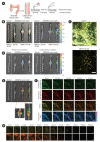Endoscopic molecular imaging in inflammatory bowel disease
- PMID: 32299156
- PMCID: PMC7873406
- DOI: 10.5217/ir.2019.09175
Endoscopic molecular imaging in inflammatory bowel disease
Abstract
Molecular imaging is a technique for imaging the processes occurring in a living body at a molecular level in real-time, combining molecular cell biology with advanced imaging technologies using molecular probes and fluorescence. Gastrointestinal endoscopic molecular imaging shows great promise for improving the identification of neoplasms, providing characterization for patient stratification and assessing the response to molecular targeted therapy. In inflammatory bowel disease, endoscopic molecular imaging can be used to assess disease severity and predict therapeutic response and prognosis. Endoscopic molecular imaging is also able to visualize dysplasia in the presence of background inflammation. Several preclinical and clinical trials have evaluated endoscopic molecular imaging; however, this area is just beginning to evolve, and many issues have not been solved yet. In the future, it is expected that endoscopic molecular imaging will be of increasing interest among clinicians as a new technology for the identification and evaluation of colorectal neoplasm and colitis-associated cancer.
Keywords: Colitis; Inflammatory bowel disease; Intestinal diseases; Molecular imaging; Neoplasm.
Conflict of interest statement
Myung SJ is an editorial board member of the journal but did not involve in the peer reviewer selection, evaluation, or decision process of this article. He is CEO of EdisBiotech Co. No other potential conflicts of interest relevant to this article were reported.
Figures




References
-
- Drossman DA. Challenges in the physician-patient relationship: feeling “drained”. Gastroenterology. 2001;121:1037–1038. - PubMed
-
- Matloff JL, Abidi W, Richards-Kortum R, Sauk J, Anandasabapathy S. High-resolution and optical molecular imaging for the early detection of colonic neoplasia. Gastrointest Endosc. 2011;73:1263–1273. - PubMed
-
- van Rijn JC, Reitsma JB, Stoker J, Bossuyt PM, van Deventer SJ, Dekker E. Polyp miss rate determined by tandem colonoscopy: a systematic review. Am J Gastroenterol. 2006;101:343–350. - PubMed
-
- Yalamarthi S, Witherspoon P, McCole D, Auld CD. Missed diagnoses in patients with upper gastrointestinal cancers. Endoscopy. 2004;36:874–879. - PubMed
-
- Dacosta RS, Wilson BC, Marcon NE. New optical technologies for earlier endoscopic diagnosis of premalignant gastrointestinal lesions. J Gastroenterol Hepatol. 2002;17 Suppl:S85S104. - PubMed
Publication types
Grants and funding
LinkOut - more resources
Full Text Sources
Other Literature Sources

